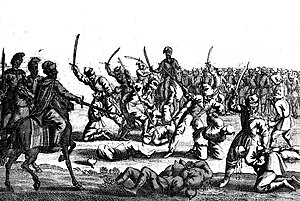Battle of Batoh

The Cossack massacre of Polish prisoners
(on the left three Cossack commanders including Iwan Zołotarenko , in the middle the Nogai execution squads and on the right in the background the remaining prisoners waiting to be executed; copperplate engraving from Allgemeine Schaubühne der Welt by Job Ludolf and Christian Juncker , 1713)
| date | June 1st and 2nd, 1652 |
|---|---|
| place | Batoh , Kingdom of Poland , now Ukraine |
| output | Victory of the Zaporozhian Cossacks and Crimean Tatars |
| Parties to the conflict | |
|---|---|
| Commander | |
|
Hetman Bohdan Khmelnytskyi
|
Hetman Marcin Kalinowski †
|
| Troop strength | |
| up to 50,000 men | up to 15,000 men |
| losses | |
|
unknown |
8,000 executed |
Shovti Vody (1648) - Korsun (1648) - Starokostjantyniw (1648) - Pyljawzi (1648) - Pohost (1648) - Lojew I (1649) - Zahal (1649) - Sbarash (1649) - Sboriw (1649) - Krasne (1651 ) - Kopytschynzi (1651) - Berestechko (1651) - Lojew II (1651) - Bila Tserkva (1651) - Batoh (1652) - Kamyanets-Podilskyj (1652) - Monastyryschtsche (1653) - Suceava (1653) - Schwanets (1653)
The Battle of Batoh was a battle that took place in 1652 near Batoh near the village of Cheetwertynivka ( Четвертинівка ) in Vinnytsia Oblast in what is now Ukraine between the troops of Poland-Lithuania under the leadership of Crown Hetman Marcin Kalinowski on the one hand and the Zaporozhian Cossacks in league with the Crimean Khanate on the other. The Cossacks emerged victorious from the battle, taking up to 8,000 prisoners who were massacred after the battle. Among the victims of the massacre were the military commanders Samuel Jerzy Kalinowski, Zygmunt Przyjemski, Jan Odrzywolski and Marek Sobieski.
background
In 1652 the ataman of the Zaporozhian Cossacks, Bohdan Khmelnyzkyj , marched with his troops towards the Principality of Moldova in order to forge an anti-Poland alliance with Prince Vasile Lupu . To this end, a marriage of his son Tymofij with Ruxandra, a daughter of the Moldovan ruler, should underline the serious will to form an alliance for the time being.
Hetman Marcin Kalinowski, the leader of the Polish Crown Army , decided to intervene. In May 1652 he gathered a force around him, which was to put the Cossacks and their allies, the Crimean Tatars, in the battle camp near Batoh.
The army strength of the Polish side is estimated at up to 15,000 men, that of the Cossacks and Tatars at up to 50,000 fighters.
The battle
The Poles made fatal tactical mistakes even before the battle by allowing the Cossacks and Tatars to cross the Boh River . Shortly afterwards, the Polish combat camp was quickly surrounded, which soon led to tension between Kalinowski and the rest of the commanders. On June 1, the first battle between the warring parties broke out. The Poles successfully repelled this attack, but tensions about the right tactics deepened and parts of the Polish army revolted. Some wanted to stay and fight, others wanted to flee from the enemy. In this chaotic situation there was renewed fighting the next day, in which the Poles were defeated by the Cossack-Tatar force. Hetman Kalinowski fell at the side of his son Samuel during the battle.
The massacre and the consequences
After the battle went up to 8,000 men in the Cossack captivity, which then in revenge for the Cossack defeat in the Battle of Beresteczko 1,651 killed were.
: Among the victims of the battle and the massacre included, among others Samuel Jerzy Kalinowski Polish Kronkanzlers, the son of Polish Hetman and son Jerzy Ossoliński , January Odrzywolski , captain of the Cossack cavalry and Castellan of Chernihiv , Zygmunt Przyjemski , General of the Polish artillery and infantry , Marek Sobieski , Rittmeister of the Polish cavalry, Starost von Krasnystaw and Jaworów and older brother of the future Polish King Jan III. Sobieski . Among the few survivors of the massacre were u. a. Krzysztof Grodzicki , general of the Polish artillery and Stefan Czarniecki , Polish national hero in the fight against the Swedes and hetman of the Polish crown.
In the Battle of Batoh and the subsequent massacre, the best units of the Polish crown were destroyed. Although the losses of the Polish Army were quickly replaced in the years that followed, the loss of the most experienced military commanders and units weighed heavily. Due to the defeat, the Poles temporarily lost military control over large parts of Ukraine and enabled their enemies to launch powerful offensives against the Kingdom of Poland-Lithuania by the Russians (from 1654) and Swedes (from 1655).
Slaughter site in today 's Vinnytsia Oblast , ( Trostyanets district ) |
Some Polish historians and journalists today also refer to the massacre after the Battle of Batoh as the first Katyn .
literature
- Boris Krupnitzky: History of Ukraine: From the Beginning to 1917 .
- Gotthold Rhode : History of Poland: An overview , Verlag Wissenschaftliche Buchgesellschaft , ISBN 3-534-00763-8 .
- Wojciech Jacek Długołęcki: Batoh 1652 , Bellona Publishing House , ISBN 83-11-08402-5 (Polish).
- Richard Brzezinski: Polish Armies 1569-1696 (2): 1569-1696 , Osprey Publishing , ISBN 978-0-85045-744-5 (English).
Web links
- Battle of Batoh 1652 (English).
- Stefan Czarniecki (1599–1665) (English).
- The Second Cossack War (English).
Coordinates: 48 ° 36 ' N , 29 ° 17' E
